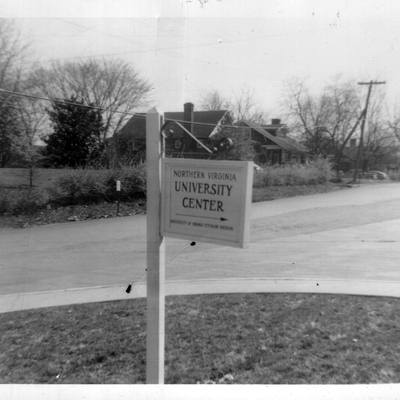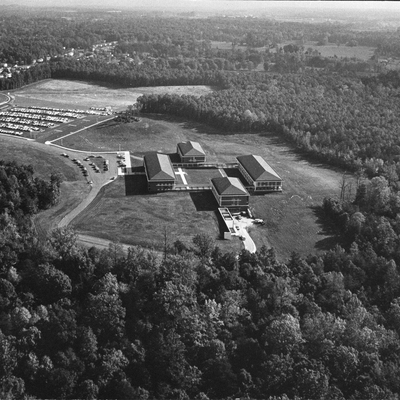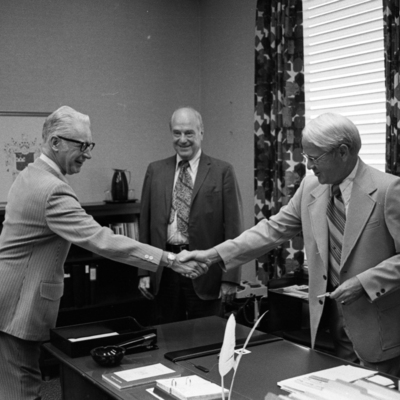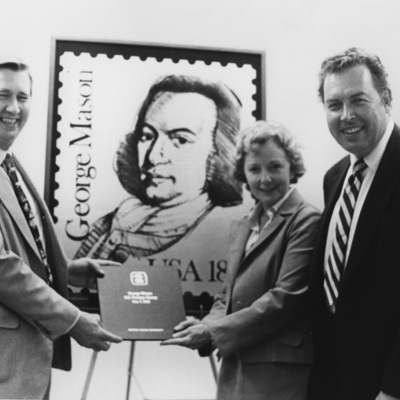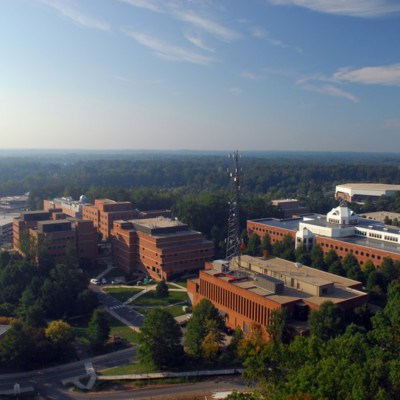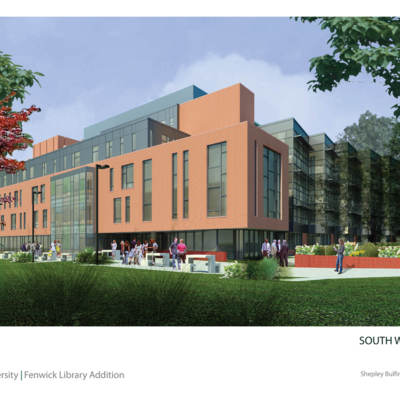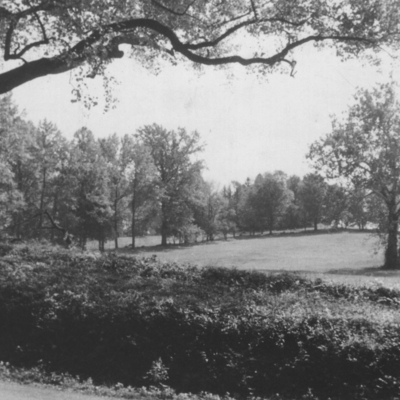Dr. Alan Merten, George Mason, and Sixteen Years of Trying to Do it The Right Way
Alan Merten’s journey to become President of the University began long before his appointment in 1996. Dr. and Mrs. Merten were married in Northern Virginia in 1967 and followed the growth of the University throughout the years. He could have had no idea that thirty years later he would lead the University through an unprecedented stage in its development and be marked as one of the greatest contributors to the young school’s already-rich history.
Alan Gilbert Merten was born and raised in Milwaukee, Wisconsin, where he attended both the Universities of Wisconsin at Milwaukee and Madison in his undergraduate years to study mathematics. He joined the Air Force shortly after graduation, and his first assignment was to get his Master’s degree from Stanford University in Computer Science. Upon completing the degree, he worked in the Pentagon’s computer center for three years and served as military aid to President Lyndon B. Johnson. He met and married his wife, Sally during this time and after completing these assignments, he returned to the University of Wisconsin-Madison and earned his doctorate in Computer Science. His time in the Air Force had piqued his interest in computing—he enjoyed research and teaching, so he thought becoming a university professor would offer the best of both worlds. Though he considered working for a big technology-focused corporation, he decided to follow the example of professors who had inspired him to teach. That career choice profoundly shaped the rest of his life. [1]
Dr. Merten’s first position was as a professor of industrial and operations engineering at the University of Michigan. There he developed an interest in the business applications of the computer. After his first four years of teaching, he transferred from the engineering school to the business school to teach the application of computer science to business. This eventually led to his teaching programs for business executives as well, and soon he was offered his first administrative position: Associate Dean for Executive Education and Computing Services at the School of Business. [2]
In 1986 Dr. Merten became dean of the School of Business at the University of Florida and remained there until 1989 when he accepted the position as Dean of the Johnson Graduate School of Management at Cornell University.
After serving at Cornell for seven years, Dr. Merten was ready to take on another role. He looked at advertisements for university presidents around the time of Dr. Johnson’s approaching retirement, and as fate would have it, he received a call from none other than George Mason University’s presidential search firm in December 1995 asking if he had any interest in the position. He did. By February 1996, the committee had narrowed the applicants to ten and asked Dr. Merten to come to Fairfax for a meeting. On his way back to Ithaca, he received another call saying they had further reduced the number to four, and that they hoped he might return. Interestingly, he later found out that his background was well-suited to specific criteria the search committee desired; one member had actually suggested to the committee: “I know it’s not possible, but it would be great if the new President had a Ph.D. in computer science.” [3] Dr. Merten was offered the position based on his many other qualifications, however, after talking with his wife and some colleagues, he decided that it was “the place to be.” [4]
Dr. Merten knew George Mason had a reputation for being a “very innovative university; what Dr. Johnson had created was an environment where things were happening …often in a somewhat brash way that got people’s attention.” [5] He saw that it was a university that took advantage of its location, and he also associated it with a place where those who were “innovative” --particularly in regard to faculty--and who did not quite seem to fit at other universities could find a home. George Mason held “both the excitement and downsides of youth.” [6]
Dr. Merten already had an established vision by the time he took office in 1996. He sought to develop a great university in the greater Washington, D.C. area, to expand research activities to match the University’s strong reputation as a teaching institution and to continue to establish excellent academic programs in new areas (information technology, law, policy, economics, and performing arts were already strong disciplines). Dr. Merten understood that in order for the University to not only “survive, but thrive” it was necessary to “create order out of chaos without killing the entrepreneurial spirit.” [7] He appreciated Dr. Johnson’s approach to improving quality at Mason, but the many ideas that had been suggested by others during Johnson’s time sometimes resulted in programs, departments, institutes, and organizations that overlapped and competed with each other. Merten felt that the “let every flower bloom” mentality created the atmosphere of a “start-up company”: things were exciting, but there was a certain amount of disorder. [8]
In order to curtail that chaos and channel it into productivity, Dr. Merten saw it necessary to combine competing or non-complementary academic programs and departments. When Merten arrived, a School of Management and a Graduate Business Institute existed, so the latter was incorporated into the former. The Institute of International Education was disbanded because, according to Merten, “I wanted everyone to be international.” [9] Many other programs were dealt with similarly, but sometimes decisions were made not to merge, for example the Institute for Conflict Analysis and Resolution was not combined with any existing structure because it served a unique role. While he recognized that good organizational structure does not automatically lead to success, Dr. Merten believed that without it, an institution cannot thrive. He understood that the University had been permeated by a culture that had associated innovation with new things, like the creation of new institutes, but his plan called for a different tactic:
"What we’d do is go into existing things and tell people you have to become innovative, as opposed to creating something new. We had to merge things that had been created for the purposes of innovation. We had to convince people on campus that new organizations weren’t the only ones that were going to be innovative. Existing organizations had to be innovative, too. That was a little bit hard for a while; people had associated the creation of a new entity with innovation and the old entity with lack of innovation. We couldn’t do that—we couldn’t afford that." [10]
In a time of transition, Dr. Merten’s new method faced some criticism. He was proud of the University and wanted to keep its spirit alive while also giving it some more traditional elements, using UCLA and UC Irvine as examples. They were older institutions in metropolitan areas that had been involved in their communities and had solid reputations for teaching, which they had parlayed into research. This was a challenging proposition when most thought of Mason as non-traditional; many thought his attempts to create order would kill the entrepreneurial spirit, but Dr. Merten believed the lack of order itself would kill that spirit. Doubt about his plans also surfaced initially because his style was different from that of Dr. Johnson. A colleague once told him, “You’re replacing a cowboy—someone who comes charging into the room, shooting in all directions, makes things happen, and maybe takes a few casualties…There are two ways of getting someone’s attention: one [Dr. Johnson’s style] is to poke them in the eye.” [11]
George Johnson had created meaningful friendships for the University in the Northern Virginia community, and Dr. Merten wanted to maintain those while also expanding the University’s circle. He spent a great deal of time (almost every night during his first year as president) building relationships with the University’s existing friends and also “going places where Mason had never been.” [12] He knew he needed to attract colleagues who shared his vision and who would contribute to the University beyond their academic and administrative roles. In order to achieve both of these goals—making new friends for the University and finding new faculty members—Dr. Merten had to become involved in the Northern Virginia community. Over time, he served on the Northern Virginia Technology Council, the Northern Virginia Roundtable, the Potomac KnowledgeWay, the Federal City Council, the Greater Washington Board of Trade, the 123 Club, and various community organizations. [13] His wife, Sally, also got involved in organizations like the local public television station WETA and the Women’s Military Memorial. They wanted to be invested in the community and to have that community realize “that George Mason was here to stay and that it was going to thrive.” [14]
During Merten’s first year, a number of high-ranking university positions opened up and needed filling. He looked to hire about ten to twelve faculty and administrators, ranging from the Dean of the School of Information Technology and Engineering to the Vice President for Information Technology to the basketball coach. His vision to expand the University’s influence attracted one dean who had no previous interest. At George Mason, however, with “so many chairs around the table…empty, he realized that he could have influence not only in his chair, but also an influence [on] whom [else] we hired and in creating the organization.” [15] The combination of faculty from Dr. Johnson’s tenure and the new hires appointed by Dr. Merten signified a “dramatic change in the nature of the University,” but one that was met with a positive reaction by the Mason community. Merten recognized that people believed in the institution, knew what Dr. Johnson had done and respected it, and also knew what needed to happen next.
Dr. Merten maintains that he and Dr. Johnson were “different leaders at different times,” both admired each other and said they could not have done what the other did. To Dr. Merten, his role was different from Dr. Johnson’s and required support from all facets of the University:
Dr. Johnson was the face of the University in Richmond and all over. I had a bigger view of whom we had to touch, and I couldn’t do it all myself. I told the new deans, “When I show up at a meeting at 7:30 in the morning at Tyson’s Corner, I want someone to come up to me and say, "Gee, Alan, it’s nice that you’re here, but dean so-and-so has been here for a half an hour already.’” The first time, about a year or so after I got here, when that started to happen, I knew we were winning. [16]
In addition to merging departments and hiring new faculty, one of Dr. Merten’s first big decisions was to promote the concept of Mason as a distributed university: he assigned all three campuses equal status. He had also decided upon his arrival that there should be a major capital campaign; one had been proposed and started briefly in the early 1990s, but it had never come to fruition due to the period’s poor economic climate. A relatively quiet planning phase beginning in 1998 involved many changes in staff in the Development and Alumni Affairs Offices and the process of assessing each academic department’s needs. $78 million was raised during the pre-public phase, and the campaign was launched publicly on April 6, 2002, at a dinner celebrating the 30th Anniversary of the University’s independence. [17] Merten explained to donors that “We were trying to move George Mason from good to great, from good enough to excellent, and that was going to take private money.” [18] He believes support came because “people want to put their name on success; they want their money and name to be associated with [it].” [19] Alumni gifts were significant, even though the alumni population as a whole is relatively young. A community of 45,000 donors contributed to the campaign, which raised $142 million by its close on September 24, 2005. [20]
Dr. Merten also worked diligently to increase the opportunities made available by George Mason’s proximity to Washington, D.C. because as a friend had told him: “[l]ocation by itself doesn’t guarantee you anything. You have to take advantage of it.” [21] Merten felt that George Mason had begun to do that, but believed that it could do much more. He saw Mason as involved in five levels of community: technology, arts, and public community affairs of Northern Virginia; Virginia itself; the greater-Washington, D.C. business and arts community; the nation’s capital; and the world’s capital, stressing the last two as extremely important. All were vital to Mason’s growth, however: “We have a responsibility to both contribute to and draw upon those five communities, and we do”. [22]
Another way George Mason takes advantage of its location, according to Merten, is that it provides faculty members who are well-versed in their disciplines. Students have access to both tenure-track professors who teach the theory of a discipline and the practical knowledge of adjunct professors who work in the discipline each day, as for example, at the Smithsonian Institution. Students are also given a global view. Dr. Merten stressed the importance of experiencing different cultures: “I tell students, when you walk into a classroom, sit down by someone who doesn’t look like you; they could be from one of 120 – 140 different countries.” He believed George Mason’s location provided incredible opportunities for its students: “[These are] things that our students get with relatively little effort…if they were someplace else it would take a major effort; they get it by showing up in class. And our students know that. They appreciate the location, the diversity, the rigor, and the applied aspect of what they’re getting.” [23]
That students appreciate the location, diversity, and programs at Mason is evident in the dramatic increase in enrollment that took place during Dr. Merten’s tenure. In 1996, approximately 23,000 students attended George Mason; by 2010, about 32,500 students were enrolled. [24] He has noted that the percentage of undergraduates who are full-time students has increased between fifty to sixty percent, partially due to the influx of out-of-state students--from about ten percent to twenty-five percent of the undergraduate population--and the increase in the number of students living on-campus as the University has become a primarily residential institution with a residential population of approximately 7000 students in 2012. [25] Masonvale, a large neighborhood of townhouse-style apartments for faculty and staff on the Fairfax campus, has further contributed to the residential feeling of the University.
Dormitories were not the only buildings under construction; during Dr. Merten’s presidency, over twenty major buildings were built on Mason’s three campuses, including new academic buildings like the Art & Design and Engineering buildings at the Fairfax Campus (both opened in 2009), the Biomedical Research Laboratory at Prince William (2001), and Founders Hall at Arlington (2010). The Hylton Performing Arts Center at Prince William (2009) and the Mason Inn Hotel and Conference Center at Fairfax (2010) quickly became important fixtures to their respective communities. They are facilities Dr. Merten associates with a more mature university, because they serve not only students, faculty, and staff, but also the greater community. As he later stated: “George Mason’s buildings that reach into the community are part of who we are; there wouldn’t be a George Mason without [the community], [because] George Mason was founded with the belief that Northern Virginia needed a great university and that it needed to be involved in the community.” [26] Dr. Merten takes pride in that the quality of the University—its academic programs, buildings, and campus life—has increased with demand as the University has grown, instead of the other way around.
Merten felt that the increase in quality and visibility permeated virtually every facet of Mason during Dr. Merten’s sixteen year service. “We accomplished much more than I figured we would…it’s not only what we did, but how we did it, and the pace at which we did things.” One of these big accomplishments included Vernon Smith’s winning the Nobel Prize in Economics in 2002; Mason, the only Virginia school to have one Nobel Prize-winning faculty member, now had a second. Perhaps one of the greatest achievements—and one which has had a profound impact on the University—also happened during Dr. Merten’s presidency: the Men’s Basketball team’s “Cinderella Story” journey to the Final Four in 2006.
Dr. Merten has called the Final Four trip timely: “[i]f it had happened earlier or later, it wouldn’t have had the same impact. We were on the map, and this really put us on the map. Local, state, national, international media picked up on it.” [27] George Mason appeared on the front pages of newspapers across the country—sometimes as many as 200 per day--all displaying the George Mason logo. Dr. Merten acknowledged that Jim Larranaga, the Men’s Basketball coach, “did basketball right: students first, student-athletes second,” and stressed the importance of having strong academic and athletic programs: “You’d better be doing the right things at your university in regard to academics and athletics if you ever get a hit like we did, because the media is going to write about you. The media has got to fill in either time or space—if you’re as hot as we were, they’re going to fill in good or bad; we kept them filling in with good things and they kept printing more and more.” [28] Papers like the Wall Street Journal and the New York Times asked for more and more information about the school, and Mason sent articles, brochures, letters, and interviews to them and all over the country, garnering publicity unparalleled in the University’s history. It also imbued George Mason with a spirit that has never left.
A friend once told Dr. Merten, “[e]very once in a while, the world gets a George Mason wake-up call. We all know you’ve been doing more than we expected, and then all of a sudden something happens.” [29] Mason’s appearance in the Final Four was one such occurrence; another was its designation by U.S. News and World Report as the “Number One University to Watch” in 2008 on its first-ever list of “Up-and-Coming Universities”—schools “that have recently made the most promising and innovative changes in academics, faculty, students, campus or facilities.” [30] This recognition, coming on the heels of the Final Four appearance, was huge for George Mason; it was “a major reaffirmation of what we believed we were.” [31] Dr. Merten said in 2010 that “[p]eople around the nation and around the world are stunned when I tell them we’re only thirty-seven years old because of our size, quality, and reputation. Some people tell me I’m lying!” [32]
After sixteen years of witnessing and contributing to incredible milestones in George Mason’s history, Dr. Merten will retire on June 30, 2012, and Dr. Ángel Cabrera will become the sixth president of the University. [33] Dr. Merten believes that the faces of the campuses will continue to change--with new dorms at the Fairfax campus, commercial development around the Prince William campus, and more programs at Arlington--but that the University’s mission to both contribute to and draw upon the local, national, and global communities will remain constant. He hopes Mason’s culture does not change—that it stays “one of the most innovative universities in the country” and one of the best universities to work for, and that it continues to take advantage of its location and to market itself. [34] He would also like to see more research conducted, though not at the expense of teaching, and the construction of more facilities that support research activities. “We’re doing the right things in the right way” he said, and stressed the importance of looking toward the future with care and excitement. [35]
Browse items related to Dr. Alan G. Merten.

